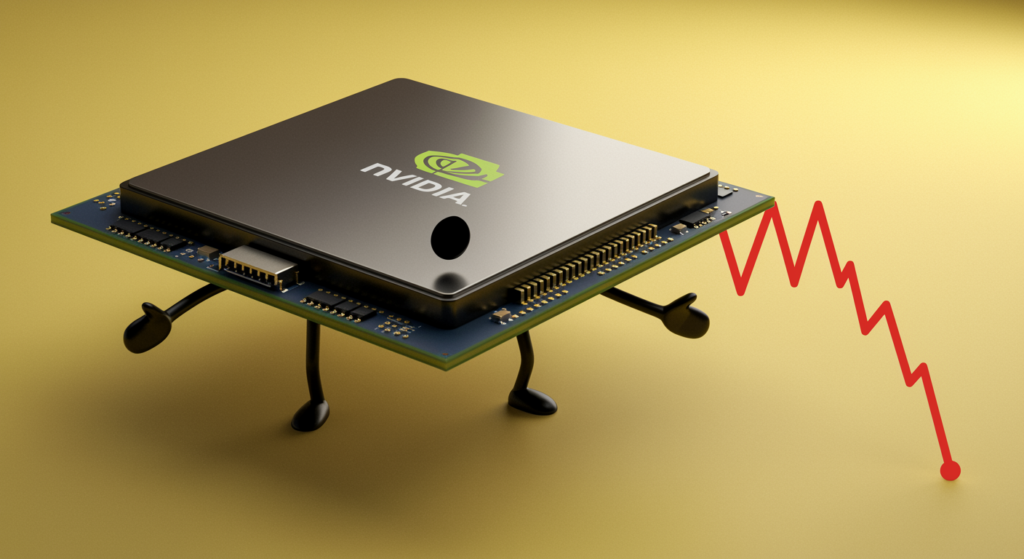
Nvidia Sell Rating: Seaport Warns AI is Fully Priced
Nvidia Faces Headwinds as Seaport Issues Rare Sell Rating
Have you ever wondered if the hype around a tech giant like Nvidia has pushed its stock too far? That’s exactly what Seaport Research is signaling with their Nvidia sell rating, warning that AI valuations might already be baked into the price. The semiconductor leader has seen its shares drop 17.4% year-to-date in 2025, amid a tangle of market challenges that could redefine its path forward. Despite Nvidia’s stronghold in AI chips, this sell rating highlights potential overvaluation, urging investors to pause and reassess.
This cautious stance from Seaport arrives as Nvidia grapples with fierce competition and production ramp-ups for its Blackwell processors. It’s a sharp pivot from the company’s explosive growth during the early AI surge, leaving many to question if Nvidia can keep up its momentum. For those tracking the Nvidia sell rating, it’s a reminder that even industry giants aren’t immune to market shifts.
Market Challenges and Chinese Competition
One major factor behind the Nvidia sell rating is the rising threat from competitors like Huawei, which is ramping up AI chip production. Recent data shows Huawei is set to challenge Nvidia’s dominance in China, potentially eroding its market share. U.S. export restrictions have limited Nvidia’s ability to ship advanced processors there, creating an opening for local alternatives.
Imagine a scenario where Chinese AI firms, long reliant on Nvidia’s tech, suddenly switch to homegrown options—it’s happening sooner than you might think. Huawei plans to ship its advanced C artificial chips next month, targeting customers who’ve been seeking replacements for Nvidia’s H20 processors. This development alone could amplify the concerns raised in Seaport’s Nvidia sell rating, as it underscores the risks of geopolitical tensions in the global AI landscape.
Trade Relations and Tariff Developments
Amid these hurdles, there’s a glimmer of hope with U.S.-China trade easing. Reports from late April suggest China has quietly lifted its 125% tariffs on certain U.S. semiconductors, which could benefit Nvidia. These exemptions cover key components like integrated circuits, potentially smoothing operations in a critical market.
Exemptions for aircraft parts also hint at thawing relations. But as investors digest the Nvidia sell rating, they should ask: Will these changes be enough to counterbalance the competitive pressures? It’s a nuanced situation that could influence AI chip market dynamics for years.
Nvidia’s Financial Performance Remains Strong
Even with the Nvidia sell rating looming, the company’s financials tell a story of resilience. In the fourth quarter ending January 26, 2025, Nvidia posted $39.3 billion in revenue—a 12% quarterly jump and 78% year-over-year growth. That kind of performance makes you think twice about the sell rating, doesn’t it?
For the full fiscal year 2025, revenue hit $130.5 billion, up 114% from the prior year, with earnings per share soaring. These numbers highlight Nvidia’s ability to innovate and capture demand, even as Seaport warns that AI is fully priced. It’s a classic case of strong fundamentals meeting market skepticism—what’s your take on balancing the two?
Blackwell Momentum and New Initiatives
Nvidia’s CEO Jensen Huang has been vocal about the “amazing” demand for Blackwell AI supercomputers, which raked in billions in their debut quarter. “Increasing compute for training makes models smarter,” Huang noted, emphasizing how this tech is driving the next wave of AI advancements. Yet, the Nvidia sell rating from Seaport suggests these gains might already be reflected in the stock price, potentially limiting future rewards.
The company is pushing forward with projects like DIGITS, a personal AI supercomputer for researchers, and expansions in generative AI for robotics and media. If you’re an investor, this innovation could be a game-changer, but it’s worth weighing against the valuation concerns in the Nvidia sell rating. Tip: Keep an eye on supply constraints, as they could impact rollout speed and overall market share.
Semiconductor Wafer Dominance
Nvidia’s grip on the semiconductor world is undeniable, with projections showing it will use 77% of wafers for AI processors in 2025. That’s up from 51% in 2024, according to Morgan Stanley, illustrating just how central Nvidia is to the AI chip market. This dominance is a key counterpoint to the Nvidia sell rating, proving the company’s scale and efficiency.
While rivals like AMD might see their shares slip, Nvidia’s control over manufacturing highlights its edge. But here’s a hypothetical: What if supply chain disruptions hit? It could exacerbate the issues Seaport is flagging with their sell rating, making diversification a smart strategy for long-term investors.
Key Drivers of Nvidia’s Long-Term Outlook
Despite the Nvidia sell rating, several strengths keep Nvidia at the forefront. Its unrivaled GPU technology, for instance, sets it apart from competitors, with a market cap of $3.34 trillion dwarfing others. This technological lead is a major reason why Big Tech firms like Alphabet and Amazon rely on Nvidia for their AI needs.
Implications of Seaport’s Nvidia Sell Rating
The Nvidia sell rating isn’t just about short-term dips; it raises questions about long-term sustainability. With AI market growth projected at 36.6% CAGR through 2030, Nvidia’s position looks solid, but Seaport’s caution signals potential overvaluation. How might this affect your portfolio—time to re-evaluate?
Elite customers and explosive demand fuel Nvidia’s outlook, yet the rating reminds us that rapid growth can lead to bubbles. Advice: Consider diversifying into emerging AI segments to mitigate risks highlighted by this sell rating.
AI Chip Market Projections
The AI chip market is on fire, expected to hit $91.18 billion by 2025 with a 45.2% CAGR. GPUs, Nvidia’s specialty, still dominate, making up about a third of the market. But as the Nvidia sell rating points out, new tech like neuromorphic chips could shake things up.
Factors like smart city investments and quantum computing are driving this boom. If you’re interested in AI, think about how trends like these might play into the concerns of Seaport’s sell rating for Nvidia—could it open doors for other players?
Seaport’s Price Target and Market Concerns
Seaport’s Nvidia sell rating comes with projections of the stock hitting $137.50 by year-end, a 26% potential rise. However, they argue that AI valuations are fully priced, citing issues like supply shortages and Chinese competition. These factors could cap gains, making the rating a wake-up call for optimistic investors.
Key worries include export limits and market saturation. Here’s an example: If Huawei gains more ground, it might directly impact Nvidia’s revenue, echoing the points in this sell rating. Stay informed by monitoring geopolitical news—it’s a simple way to stay ahead.
Investment Considerations and Outlook
Weighing the Nvidia sell rating means balancing short-term risks with long-term potential. While competition and restrictions pose challenges, Nvidia’s tech edge and customer base offer stability. What strategies are you using to navigate this?
Short-Term Challenges vs. Long-Term Potential Under the Sell Rating
The Nvidia sell rating highlights vulnerabilities like high valuations, but don’t overlook the AI revolution’s early stages. With wafer dominance and innovation, Nvidia could rebound strongly. Actionable tip: Use tools like stock screeners to compare metrics and make informed decisions based on ratings like Seaport’s.
Conclusion: Balancing Optimism and Caution
Seaport’s Nvidia sell rating might be a outlier in a generally bullish market, but it forces a reality check amid 17.4% stock drops. Nvidia’s growth metrics are impressive, yet the fully priced AI narrative adds complexity. As an investor, how will you respond—hold, sell, or dig deeper?
This evolving story in the AI chip market invites you to share your thoughts in the comments below. If you’re curious about more on semiconductors, check out our related posts on emerging tech trends. Let’s keep the conversation going—your insights could help others navigate these waters.
References
- TheStreet. “Analysts Revise Nvidia Price Target on Chip Demand.” Link.
- NVIDIA News. “NVIDIA Announces Financial Results for Fourth Quarter and Fiscal 2025.” Link.
- TOM’s Hardware. “NVIDIA to Consume 77 Percent of Wafers Used for AI Processors in 2025: Report.” Link.
- 24/7 Wall St. “NVIDIA (NVDA) Price Prediction and Forecast.” Link.
- iConnect007. “AI Chip Market Worth $91.18 Billion by 2025 at 45.2% CAGR.” Link.
- YouTube. “Related Video Source.” Link.
- YouTube. “Another Video Insight.” Link.
- ITIF. “China is Rapidly Becoming a Leading Innovator in Advanced Industries.” Link.
Nvidia sell rating, AI chip market, Seaport analysis, Huawei competition, Blackwell processors, semiconductor industry, AI valuation, Nvidia stock, AI investments, market competition







